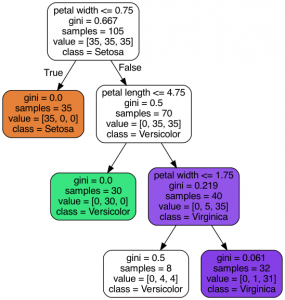

- #Visualize decision tree python without graphviz how to#
- #Visualize decision tree python without graphviz install#
- #Visualize decision tree python without graphviz code#
- #Visualize decision tree python without graphviz download#
- #Visualize decision tree python without graphviz windows#
I prefer Jupyter Lab due to its interactive features.Ĭongratulations on your first decision tree plot! Hope you found this guide helpful.
#Visualize decision tree python without graphviz code#
Within your version of Python, copy and run the below code to plot the decision tree. If you like my work, you can support me by buying me a coffee by clicking the link below. Step #3: Create the Decision Tree and Visualize it! Visualizing a Decision Tree using Graphviz & Python. Hands-On Machine Learning with Scikit-Learn.
#Visualize decision tree python without graphviz windows#
Though, setting up grahpviz itself could be a quite tricky task to do, especially on Windows machines. class B In this lecture we will visualize a decision tree using the Python module pydotplus and the module graphviz. Breast cancer data is used here as an example. As you can see, visualizing decision trees can be easily accomplished with the use of exportgraphviz library. C4.5 This algorithm is the modification of the ID3 algorithm. txt file (myfile.txt) and run dot -Tpng -O myfile.txt from the command-line to get a. Create the edge of between the object with ( -> ).

Define the direction of the graph using rankdir. Information gain for each level of the tree is calculated recursively. Let’s discussed the approach: Create a digraph object. Iterative Dichotomiser 3 (ID3) This algorithm is used for selecting the splitting by calculating information gain.

According to the information available on its Github repo, the library currently supports scikit-learn, XGBoost, Spark MLlib, and LightGBM trees. Decision Tree Algorithms in Python Let’s look at some of the decision trees in Python. If you just installed Anaconda, it should be good enough. dtreeviz library for visualizing tree-based models The dtreeviz is a python library for decision tree visualization and model interpretation. The sklearn needs to be version 0.21 or newer. Step #2: Import Packages and Read the Dataįirst, let’s import some functions from scikit-learn, a Python machine learning library.
#Visualize decision tree python without graphviz how to#
Related article: How to Install/Setup Python and Prep for Data Science NOWĬheck out step-by-step instructions on installing Python with Anaconda. (The graph was made using by python version 3.8, scikit-learn version 12.3, and graphviz software, All these software are open-sourec program).
#Visualize decision tree python without graphviz download#
Download the free version to access over 1500 data science packages and manage libraries and dependencies with Conda.
#Visualize decision tree python without graphviz install#
This is because the pydot cannot find the executable files for GraphViz, and we will need to install it manually.Anaconda Distribution is the world’s most popular Python data science platform.

Unfortunately, there was still an error message " GraphViz's executables not found". Decision Tree Visualization using GraphViz and Python - GitHub - bhattbhavesh91/visualize-decision-tree: Decision Tree Visualization using GraphViz and. So now without going into theory part, I assume if you are here then you will definitely know about, On what basic we create Decision tree like Gini impurity, Entropy, Information gain etc. That is why we will skip it here, but you can find the implementation in the Notebook on GitHub. It is also possible to use the graphviz library for visualizing the decision trees, however, the outcome is very similar, with the same set of elements as the graph above. Next, I opened an ipython notebook session in the python 2.7 virtual environment that I just built and tried to plot the graph. Decision Trees won’t be defined by a list of parameters ,So Decision Tree is a nonparametric machine learning algorithm. In this article, I am going to show you how to plot the decision trees generated by XGBoost models. Now, we can quite easily interpret the decision tree. Package plan for installation in environment /Users/kittipat/anaconda3/anaconda/envs/mypy27: The following packages will be downloaded: package | build -|- python-2.7.9 | 1 11.3 MB pyparsing-1.5.6 | py27_0 61 KB pydot-1.0.28 | py27_0 35 KB - Total: 11.4 MB The following NEW packages will be INSTALLED: pydot: 1.0.28-py27_0 The following packages will be UPDATED: openssl: 1.0.1h-1 -> 1.0.1j-4 python: 2.7.8-1 -> 2.7.9-1 The following packages will be DOWNGRADED: pyparsing: 2.0.1-py27_0 -> 1.5.6-py27_0 Proceed (/n)? y Fetching packages. We will be creating our model using the ‘DecisionTreeClassifier’ algorithm provided by scikit-learn then, visualize the model using the ‘plottree’ function. (mypy27)685b35c8f358:python_dev kittipat$ conda install pydot Fetching package metadata.


 0 kommentar(er)
0 kommentar(er)
